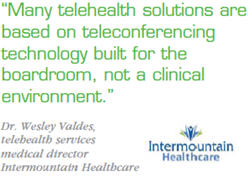Intermountain's Telehealth Triumph

By Ken Congdon
Intermountain Healthcare is changing the telehealth paradigm by abandoning departmental applications of the technology in favor of a system-wide telehealth infrastructure.
For various reasons, telehealth solutions have not yet been widely adopted by healthcare providers in the United States. Some blame reimbursement limitations. Others say the value of the technology doesn’t justify the expense. Dr. Wesley Valdes, telehealth services medical director for Intermountain Healthcare, believes these providers fail to see the big picture. In his opinion, the promise of telehealth has been limited by how the technology has been historically implemented.
 “Traditionally, telehealth technology has been applied strictly at a departmental level to create new clinical service lines for a healthcare provider,” says Dr. Valdes. “The technology is rolled out in these different departments as it is requested, and different products are often implemented as a result. For example, I know one health system that is literally trying to maintain 17 different telehealth solutions simultaneously — including Polycom, Cisco, Skype, and FaceTime. This approach can quickly become a costly organizational nightmare for a healthcare provider.”
“Traditionally, telehealth technology has been applied strictly at a departmental level to create new clinical service lines for a healthcare provider,” says Dr. Valdes. “The technology is rolled out in these different departments as it is requested, and different products are often implemented as a result. For example, I know one health system that is literally trying to maintain 17 different telehealth solutions simultaneously — including Polycom, Cisco, Skype, and FaceTime. This approach can quickly become a costly organizational nightmare for a healthcare provider.”
Intermountain Healthcare was headed down this path when Dr. Valdes came on the scene in 2011. The provider had just launched a telepsychiatry service line in conjunction with a non-Intermountain hospital. This approach didn’t align well with the health system’s overall goals for telehealth technology according to Dr. Valdes.
“Intermountain viewed telehealth as a key component in its new shared accountability model,” says Dr. Valdes. “The shared accountability model is a patient-centered care strategy that focuses on three basic goals — quality patient care, prevention, and cost management. Telehealth could definitely provide the rich set of communications tools necessary to enable this effort, but not if it was applied piecemeal. We needed to steer away from the traditional service-line approach and instead start thinking about making telehealth technology part of Intermountain’s infrastructure.”
TRADITIONAL TELEHEALTH DOESN’T FIT EXISTING CLINICAL WORKFLOWS
The cost and maintenance requirements to support traditional service-line applications of telehealth technology were not the only things that worried Dr. Valdes about following the status quo. His biggest concern was the fact that most telehealth solutions in use at hospitals simply don’t fit well within a clinical workflow.
“Many telehealth solutions are based on teleconferencing technology built for the boardroom, not a clinical environment,” says Dr. Valdes. “In a hospital or doctor’s office, patients need to go to multiple locations (e.g. reception desk, waiting room, exam room) and see many different people (e.g. receptionist, nurse, doctor). Replicating this workflow in a teleconferencing environment requires call-hold and forwarding capabilities unavailable with most teleconferencing systems. As a result, health providers modify their workflow to make use of the technology, setting up special rooms where the equipment is installed and the doctors must go to conduct a video call.”
Moreover, traditional videoconferencing technology doesn’t provide a means for patients to fill out the forms and exchange the personal identification information necessary for a typical doctor’s appointment. Fax transmissions often need to be coordinated with these videoconferences to obtain these forms, which can often result in data errors and missing information.
INTERMOUNTAIN USES EMPLOYEES TO PROVE ITS TELEHEALTH CONCEPT
Led by Dr. Valdes, Intermountain set out to create an enterprise-wide telehealth system that not only allowed video calls to be routed to clinicians in line with their dayto- day clinical workflows, but also incorporated e-form capabilities. Given the magnitude of this telehealth initiative, Intermountain decided it was necessary to prove the concept before embarking on a full-scale deployment.
 Intermountain found it had a built-in beta test site with its own employees. The health system established a telehealth infrastructure that allowed select employees and their dependents covered under the SelectHealth insurance plan to virtually meet with a clinician.
Intermountain found it had a built-in beta test site with its own employees. The health system established a telehealth infrastructure that allowed select employees and their dependents covered under the SelectHealth insurance plan to virtually meet with a clinician.
The service is called Intermountain TeleHealth Services eVisit. The solution is browser-based, allowing designated employees to enter a URL (www.evisit.intermountainhealthcare.org), click a button, and begin a virtual doctor visit.
The application initially connects patients to a receptionist, who asks them to complete the necessary treatment forms. These forms are available for the patients to complete and sign online. Furthermore, patient identification and insurance information can be captured directly through the interface. The receptionist simply asks the patients to hold these cards up to the camera, snaps a picture, and date-stamps it with the form for inclusion in the electronic medical record.
Next, the patient is placed on hold (Intermountain refers to this as a virtual waiting room) and transferred to an exam room where a doctor or nurse is available to perform a consultation. The Intermountain doctors, nurses, and receptionists stay at their existing workstations and maintain their existing workflows. They don’t have to go to a designated teleconferencing room to engage in the eVisit. Instead, the video call is moved around the clinic, just as a patient moves around a clinic. Doctors and nurses simply accommodate virtual patients within the flow of their regular work day; no special accommodations need to be made to support this interaction.
Finally, the eVisit site is completely open to eligible employees. No username or password is required to access the site. “We don’t require patients to have a username or password to call or visit our clinics,” says Dr. Valdes. “Why would we put this barrier in place to engage in an online consultation? We simply authenticate the interaction the exact same way we would with a physical visit — by collecting personal identification and insurance information.”
A TELEHEALTH INFRASTRUCTURE IMPROVES THE PATIENT EXPERIENCE
Intermountain assembled its eVisit proof-of-concept solution in just three months, and it has been an undeniable success. The next step is to open the solution up not just to Intermountain employees, but also to the entire Intermountain patient population. The provider is currently working with select payers in Utah to make eVisit interactions an option for policy holders.
In the meantime, Intermountain is also working to extend the use of telehealth technology throughout its care facilities. “We’ve elected to create what we call personalized patient rooms,” says Dr. Valdes. “This extends the technology we currently have in our eVisitequipped clinic and places it in every patient room throughout our 22 hospitals.”
Placing telehealth technology in every patient room at Intermountain does more than provide patients with access to just about any physician in the system regardless of their geographic location. It also makes other resources, such as case managers, home health nurses, surveillance monitors, and interpreters, available at the drop of a hat.
Intermountain is also using its telehealth infrastructure to improve the patient experience. For example, the system allows patients to leverage the videoconferencing technologies in their rooms to video chat with their families when it is not in use for medical purposes.
Finally, Intermountain’s telehealth infrastructure has also naturally lent itself to an entertainment solution. “The infrastructure for a telehealth solution and an entertainment solution is essentially the same,” says Dr. Valdes. “At the end of the day, they’re just different types of video packets. By incorporating patient entertainment and education into our telehealth infrastructure, we save more the $20 million in infrastructure costs. Plus, we can provide our patients with access to Netflix, games, educational videos, and other entertainment and education options that improve their overall care experience.”
